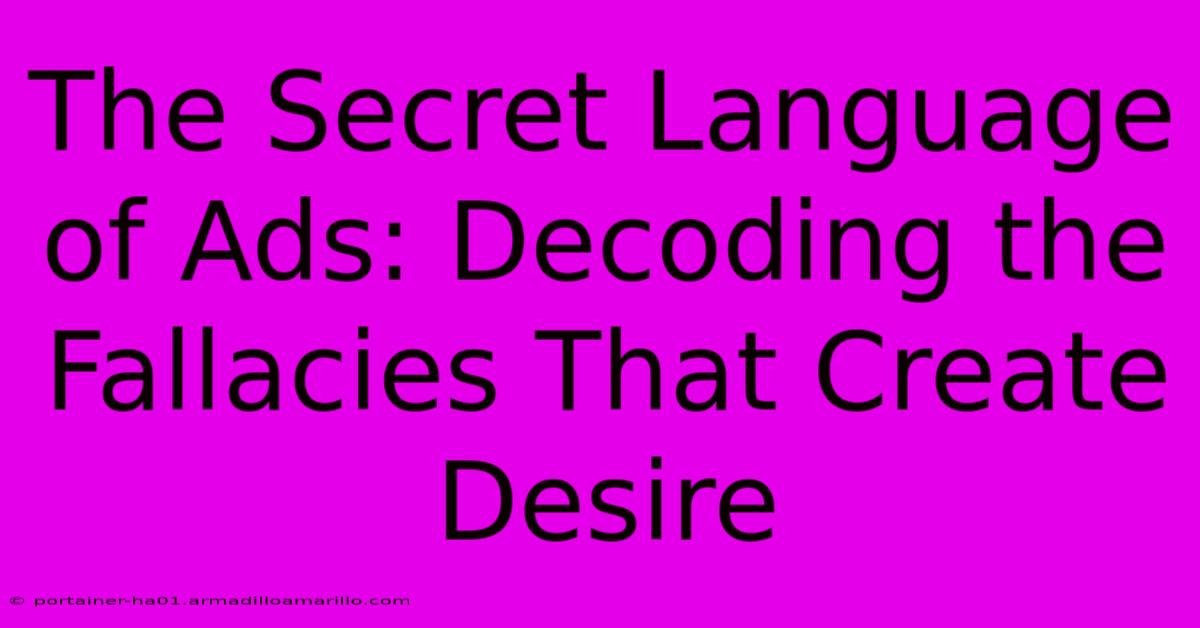The Secret Language Of Ads: Decoding The Fallacies That Create Desire

Table of Contents
The Secret Language of Ads: Decoding the Fallacies That Create Desire
Advertising is a powerful force shaping our desires and influencing our purchasing decisions. But how do ads achieve this seemingly magical feat? The answer lies in understanding the subtle, often deceptive, language they employ. This article delves into the common fallacies and persuasive techniques advertisers use to create desire and manipulate our choices. We'll uncover the secrets behind the seemingly innocent phrases and visuals that subtly nudge us toward the cash register.
The Power of Suggestion: More Than Meets the Eye
Advertising isn't just about stating facts; it's about creating a feeling. Advertisers masterfully manipulate our emotions using various techniques. One powerful technique is suggestion. Instead of directly claiming superiority, they imply it through carefully chosen words and imagery.
Examples of Suggestive Advertising:
- "Experience the Luxury": This doesn't define what "luxury" entails, leaving it up to the consumer to associate their own positive feelings with the product.
- Images of Happy Families: These visuals subconsciously link the product with feelings of joy, belonging, and contentment, creating a desire to achieve that same happiness.
- Subliminal Messaging: While often debated, the placement of subtle cues within ads can influence subconscious desires.
Exploiting Psychological Biases: The Science of Persuasion
Advertising relies heavily on understanding and exploiting common psychological biases. These inherent cognitive shortcuts can be leveraged to make products seem more appealing than they actually are.
Common Psychological Biases Used in Advertising:
- Anchoring Bias: Presenting a high initial price followed by a "discounted" price makes the lower price seem like a steal, even if it's still relatively high.
- Bandwagon Effect: Highlighting the popularity of a product creates a sense of urgency and social pressure, prompting consumers to join the "crowd."
- Scarcity Principle: Limited-time offers or limited quantities create a sense of urgency and fear of missing out (FOMO), encouraging impulsive purchases.
- Appeal to Authority: Using endorsements from celebrities, experts, or trusted figures lends credibility to the product, even if the endorsement lacks genuine substance.
Unmasking the Fallacies: Identifying Deceptive Tactics
Many advertisements employ logical fallacies to manipulate our thinking and create a false sense of need. Learning to identify these fallacies empowers us to make more informed purchasing decisions.
Common Logical Fallacies in Advertising:
- Appeal to Emotion (Pathos): Ads often evoke strong emotions like fear, joy, or sadness to bypass rational thought. Fear-mongering ads are a prime example, exaggerating risks to promote a solution.
- False Dilemma (Either/Or): Presenting only two options, often one being significantly less desirable, forces the consumer to choose the advertiser's preferred option.
- Hasty Generalization: Making sweeping claims based on insufficient evidence. For example, "9 out of 10 dentists recommend..." without providing context or supporting data.
- Red Herring: Distracting from the product's shortcomings by focusing on unrelated positive aspects or emotionally charged themes.
Becoming a Critical Consumer: Decoding the Message
Understanding the underlying language of advertising is crucial to becoming a more discerning consumer. By learning to identify the subtle techniques and fallacies used, we can make more rational purchasing decisions, avoiding impulsive buys based on manipulative tactics.
Key Takeaways:
- Be aware of suggestive language and imagery.
- Recognize and challenge psychological biases.
- Identify and question logical fallacies.
- Think critically about endorsements and testimonials.
- Consider the value proposition beyond emotional appeals.
By becoming more aware of the techniques used in advertising, we can navigate the world of marketing with a critical eye, making purchasing decisions based on informed reasoning rather than emotional manipulation. The secret language of ads is no longer a mystery; with knowledge and awareness, you hold the power to decode the message and make choices that align with your true needs and values.

Thank you for visiting our website wich cover about The Secret Language Of Ads: Decoding The Fallacies That Create Desire. We hope the information provided has been useful to you. Feel free to contact us if you have any questions or need further assistance. See you next time and dont miss to bookmark.
Featured Posts
-
Dragons Dice And Dazzling Nails A Perfect Match For D And D Enthusiasts
Feb 07, 2025
-
Transform Your Nails With Dnd The Ultimate Guide To Gel Manicure Mastery
Feb 07, 2025
-
The Quantum Pine Cone How Time Curves And Distorts Our Reality
Feb 07, 2025
-
Lavenders Lullaby Drift Into Serene Slumber With The Sweetest Purple
Feb 07, 2025
-
Ignite The Spark Of Romance With These Heartfelt Valentines Day Valentine Cards
Feb 07, 2025
